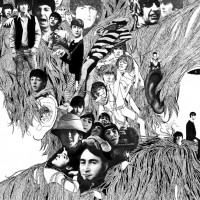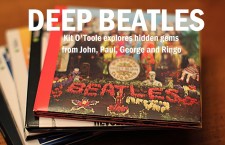What do acid, Peter Fonda, and an argument have in common?
All of these elements led to the recording of “She Said She Said,” the Revolver track known for another fact: Paul McCartney did not participate in the session. Nevertheless, “She Said She Said” stands as a classic example of the Beatles’ musical and lyrical experimentation.
The idea for the track originates from an Aug. 24, 1965 party which occurred during the Beatles’ U.S. tour. Held at the Beatles’ rented house in Los Angeles, the party saw the group hosting such luminaries as Roger McGuinn, David Crosby, and Fonda. During the event everyone except Paul McCartney dropped acid; when George Harrison experienced disturbing hallucinations, Fonda attempted to soothe Harrison.
According to the Beatles Bible website, Fonda told Harrison about how he had almost died at 10 years old after accidentally shooting himself in the stomach. John Lennon overheard Fonda stating “I know what it’s like to be dead”; annoyed and upset by his words, Lennon replied “You’re making me feel like I’ve never been born. Who put all that shit in your head?” After Lennon recovered from the trip, he remembered Fonda’s declaration and wrote a song around the phrase. In Anthology, Harrison described how he contributed to the writing of “She Said She Said”:
I was at his house one day — this is the mid-’60s — and he was struggling with some tunes. He had loads of bits, maybe three songs, that were unfinished, and I made suggestions and helped him to work them together so that they became one finished song, “She Said She Said.” The middle part of that record is a different song: ‘She said, “I know what it’s like to be dead,” and I said, “oh, no, no, you’re wrong…’” Then it goes into the other one, “When I was a boy…” That was a real weld.
Lennon continually experimented with the tune, as his home demos demonstrate. He changed the perspective from “I” to “she,” used obvious (and temporary) filler phrases like “it’s making me feel like my trousers are torn.” As the song slowly developed, he added a middle eight that varied in tempo and tone, beginning with the line ‘“When I was a boy.” As he told Rolling Stone in 1968:
Yeah, right. That was pure. That was what I meant all right. You see when I wrote that I had the “She said she said,” but it was just meaning nothing, it was just vaguely to do with someone that had said something like he knew what it was like to be dead and then it was just a sound. And then I wanted a middle eight. The beginning had been around for days and days, and so I wrote the first thing that came into my head and it was “When I was a boy,” in a different beat, but it was real because it just happened.
Less than a year later, the Beatles were wrapping up recording sessions for Revolver when they realized they were one song short for the final track lineup. John Lennon retrieved “She Said She Said” from his song stockpile, and the group laid down the tracks for the song in a marathon nine-hour session which lasted from 7:45 p.m. until 3:45 the next morning. The Beatles rehearsed the song an astounding 25 times, then laid down the basic rhythm track in three takes. During the intense session, Paul McCartney argued with other band members, and walked out of the studio.
In Many Years From Now, McCartney vaguely described the incident: “John brought it in pretty much finished, I think. I’m not sure but I think it was one of the only Beatle records I never played on. I think we’d had a barney or something and I said, ‘Oh, fuck you!’ and they said, ‘Well, we’ll do it.’ I think George played bass.”
While the full extent of the argument may never be known, it is apparent that Harrison did play bass on “She Said She Said.” After recording the rhythm track (drums, guitar, and bass), the Beatles completed the song with Lennon adding lead vocals and both he and Harrison recording backing vocals. According to the Beatles Bible and Mark Lewisohn’s Complete Beatles Recording Sessions, the four-track tape was full, so George Martin and engineer Geoff Emerick created a reduction mix. After this task was completed, Harrison contributed his lead guitar and Lennon played an organ part. Three mono mixes were made, but they were all discarded in favor of another mix created the next day.
In his typically understated way, Lennon once described “She Said She Said” as “an interesting track. The guitars are great on it. It was an acidy song.” “Interesting” barely scratches the surface of the track’s structural and thematic complexity. The tempo and rhythm patterns change frequently, a challenge Ringo Starr rises to meet admirably. Busy but never overpowering the vocals and other instruments, Starr drums to highlight certain phrases such as “you’re making me feel like I’ve never been born.”
Harrison’s lead guitar pierces through the track, slightly distorted as if to underscore the song’s hallucinogenic qualities. The song is structured in three parts: the main section, beginning with variations on “She said I know what it’s like to be dead”; the second occurring during two middle-eight sections, signaled by “when I was a boy,” and the final section, with the tempo increasing as Lennon and Harrison repeat the phrases “I know what it is to be sad” and “I know what it’s like to be dead.” One senses the narrator is undergoing a particularly intense experience, spinning into a chaotic and disturbing state.
Lyrically, John Lennon illustrates how his writing skills had developed in a short time. While he still wrote love songs, he began looking internally as well as externally, a trend starting with songs like “I’m a Loser” from Beatles For Sale. The first verse starts as a conversation, with an unnamed woman informing the narrator that she knows “what it’s like to be dead” and curiously adding “I know what it is to be sad,” suggesting that she may be describing another type of death: the absence of joy. This upsets the narrator, asking her “who put all those things in your head, things that make me feel that I’m mad.” This confrontation is “making me feel like I’ve never been born,” perhaps hinting at depression and an overall loss of hope.
When the woman protests that the narrator did not understand her, he responds that “when I was a boy, everything was right” as the key rises. As in “Help!” where Lennon longed for a carefree past, “She Said She Said” features words describing the innocence of youth before reality descends. He would continue exploring this theme in “Strawberry Fields Forever” and “Dear Prudence.” Listen to the words as the song progresses: the narrator becomes increasingly agitated, proclaiming that he wants to leave.
He repeats the middle eight as if asserting his right to happiness, determined not to let the woman’s morbid thoughts enter his imagination. However, the song fades with the woman’s words, the tempo speeding up as if engulfing the man in a nightmarish state. “She Said She Said” rightfully became one of the Beatles’ favorite tracks, as evident by the group performing a segment of it during the Get Back/Let It Be sessions.
Like “Tomorrow Never Knows,” “She Said She Said” represents John Lennon at his most creative and experimental. His willingness to shatter traditional notions of song structure and lyrical themes helped set the Beatles apart from other groups, paving the way for future artists to veer from manufactured material and further test the boundaries of the rock and pop genres.
- How John Lennon Came Roaring Back on the Beatles’ White Album - November 22, 2023
- Five ‘With the Beatles’ Deep Cuts That Illustrate Their Lasting Debt to R&B - November 20, 2023
- Five Must-Hear Deep Cuts from the Beatles’ ‘Past Masters’ - March 7, 2023



